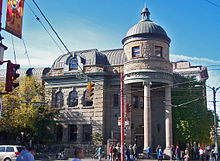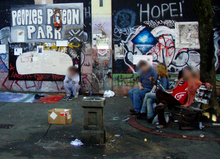Downtown Eastside
One of the city's oldest neighbourhoods, the DTES is the site of a complex set of social issues, including disproportionately high levels of drug use, homelessness, poverty, crime, mental illness and sex work.
[26] As tourist traffic declined, the neighbourhood's hotels became run-down and were gradually converted to single room occupancy (SRO) housing, a use which persists to this day.
The neighbourhood began a marked shift before Expo 86, when an estimated 800 to 1,000 tenants were evicted from DTES residential hotels to make room for tourists.
[31] Meanwhile, the provincial government adopted a policy of de-institutionalization of the mentally ill, leading to the mass discharge of Riverview Hospital's patients, with the promise that they would be integrated into the community.
[27] Many of the de-institutionalized mentally ill moved to the DTES, attracted by the accepting culture and low-cost housing, but they floundered without adequate treatment and support and soon became addicted to the neighbourhood's readily available drugs.
[45] In the 21st century, considerable investment was made in DTES services and infrastructure, including the Woodward's Building redevelopment and the acquisition of 23 SRO hotels by the provincial government for conversion to social housing.
[55] A 2016 study found that 52% of those DTES residents who experience chronic homelessness and serious mental health issues had migrated from outside Vancouver in the previous 10 years.
[61] According to the city government, Hastings Street is valued by SRO residents as "a place to meet friends, get support, access services and feel like they belong.
[107] Over the years, this has also contributed to the many missing and murdered Indigenous women and girls (MMIWG) cases, including those involved in the mass killings by serial killer Robert Pickton.
"[112] In addition to reported crime, the DTES has the highly visible street disorder, which The New York Times described as "a shock even to someone familiar with the Lower East Side of Manhattan in the 1980s or the Tenderloin in San Francisco.
[115] High crime rates and difficulties in obtaining affordable property insurance deter legitimate businesses from opening or staying in the area, resulting in many vacant storefronts.
[20] Even at their best, the SROs lack living space, resulting in tenants spending more time in the public areas of the DTES, including its street-based drug scene.
Although SROs have well-known problems, each SRO resident who loses their room and ends up on the street costs the provincial government approximately $30,000 to $40,000 per year in additional services.
[46] Due to rising rents and often-decrepit conditions in the area's remaining 4,484 privately owned SROs, DTES activists have called for governments to replace them with a further 5,000 social housing units for low-income singles.
[44] A 2015 study of DTES SRO residents found that they were eight times more likely to die than the national average, mostly due to psychosis and hepatitis C-related liver dysfunction.
[141] Several overlapping sets of data exist on costs related to the DTES: For the police, success is measured in how well the drugs are kept corralled on Hastings between Cambie and Main, where they can expect the fewest complaints.
[149] The VPD engages in the controversial practice known as "carding," or "street checks," in which police stop and question individuals whom they suspect of being involved in criminal or suspicious activity.
Some civil rights groups believe the VPD's practices constitute racial profiling and result in excessive harassment and violence against Indigenous and Black residents.
[159] You keep dumping money in, building social housing and filling it up with people from all around the region and the country ... they all get chemically dependent, and it's just more sales for the drug dealers.The Downtown Eastside has become the last place where everybody runs to from across Canada.
Some advocates for vulnerable populations believe that many DTES residents would have a better quality of life and improved chances of health if they could separate from the neighbourhood's predatory drug pushers and pimps.
[6] Vancouver Coastal Health says that the lack of appropriate care for complex social and health issues outside of the DTES often does not allow people "the choice to remain in their home community where their natural support systems exist... A common barrier that prevents mentally ill and addicted people from living outside of the DTES is a lack of appropriate services and support.
"[56] Proposals to add social housing and services for those with addiction or mental health issues to other Metro Vancouver neighbourhoods are often met with Nimbyism, even when residents selected for such projects would be low-risk individuals.
[163] A 2012 poll of Metro Vancouver residents found that although nine out of 10 of those surveyed wanted the homeless to have access to services they need, 54% believed that "housing in their community should be there for the people who can afford it.
[168] Proponents say that new developments revitalize the area, improve the quality of life, provide new social housing, and encourage a stronger retail environment and a stabilizing street presence.
[61][166] They emphasize that their goal is for the DTES to include a mixture of income levels and avoid the problems associated with concentrated poverty, not to become an expensive yuppie-oriented neighbourhood like nearby Yaletown.
[61][169][170] Others oppose the addition of market housing and upscale businesses to the DTES, in the belief that these changes will drive up prices, displace low-income residents, and make poor people feel less at home.
[143] The city's 2014 Local Area Plan for the DTES does not propose solutions to the neighbourhood's drug problems; an article in the National Post described it as a "221-page document that expertly skirted around any mention of the Downtown Eastside as a failed community in need of a drastic turnaround.
[88] A 2016 study of youth who used illicit drugs in Vancouver indicated that 28% had tried unsuccessfully to access addiction treatment in the previous 6 months, with the lack of success primarily due to being placed on waiting lists.
[176] After the city and police department described an emerging mental health crisis in Vancouver in 2013, the province implemented three of their five recommendations within a year, including new Assertive Community Treatment teams and a nine-bed urgent care facility at St. Paul's Hospital.
[48] In 2009, the VPD proposed creating a steering committee of senior city and provincial stakeholders, which would be mandated to improve collaboration between service providers to enable a client-centric rather than a discipline-centric model.














